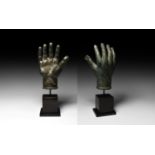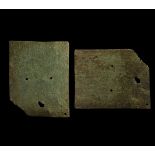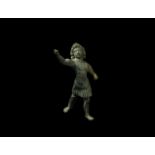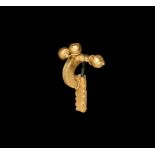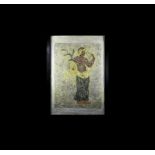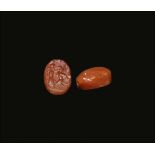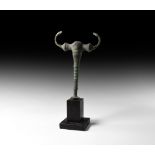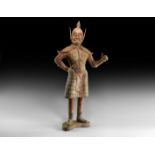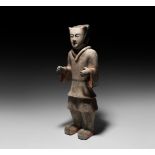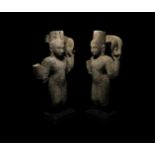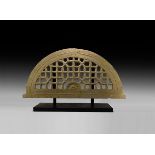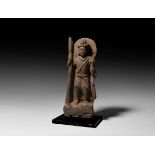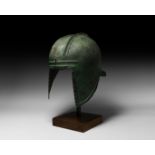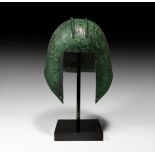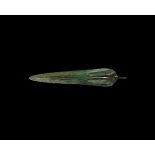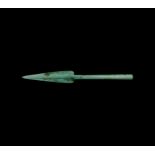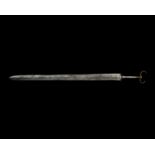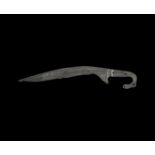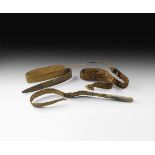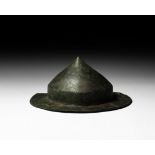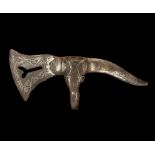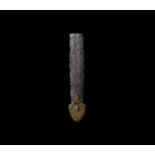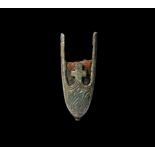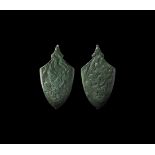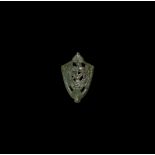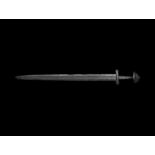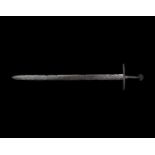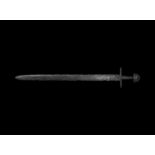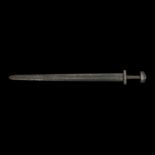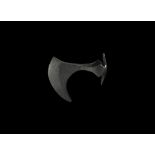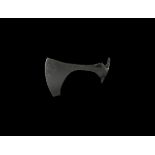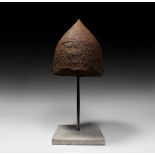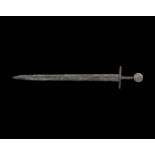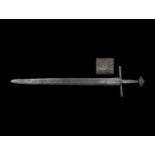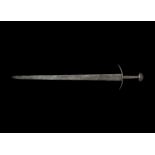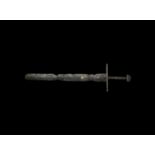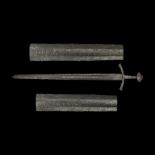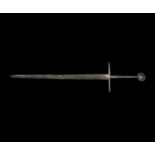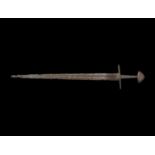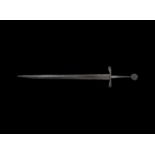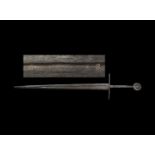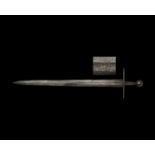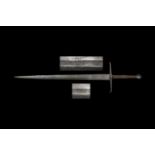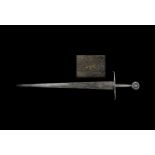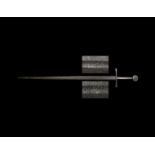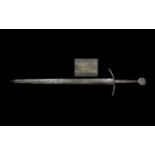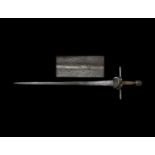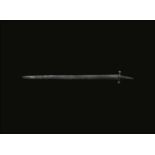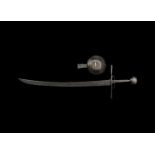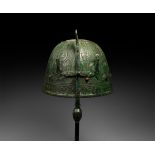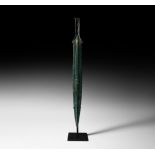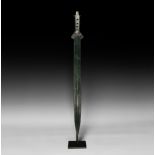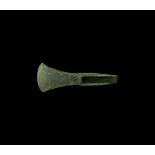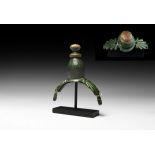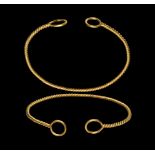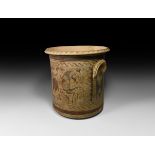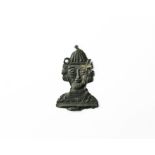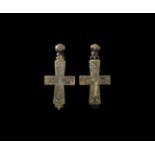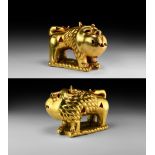Refine your search
Filtered by:
- Category,
- Item Type
- List
- Grid
A subscription to the Price Guide is required to view results for auctions ten days or older. Click here for more information
2nd-3rd century AD. A life-sized bronze hand with open palm, the fingers raised as a stop sign with well-marked detailing, socketted at wrist to a...
Dated 26th October 153 AD. A bronze rectangular diploma tablet with dense text in two paragraphs of capitals to one face and to the other a single...
2nd-3rd century AD. A bronze statuette of a Roman warrior god in a striding stance, wearing a muscled armour (statos), over a thoracomacus with pe...
Roman Gold Crossbow Brooch
4th century AD. A fabricated crossbow brooch with square-section transverse arm, three onion-shaped knops with beaded wire collars, scrolled loops...
1st-3rd century AD. A rectangular mosaic floor panel depicting a naiad nymph, minor goddess of watery elements, depicted as a beautiful young woma...
626-539 BC. A carnelian scaraboid with intaglio scene to the underside of a kilted hero gripping the neck of an attacking gryphon; accompanied by ...
13th-6th century BC. A bronze standard finial comprising a ribbed tubular socket with flanged mouth, bulb terminal with lateral spurs each curved ...
Tang Dynasty, 618-906 AD. A substantial ceramic figure of a guard standing on a crescent base, wearing a domed helmet with spike and lateral flaps...
Chinese Han Standing Figure
Han Dynasty, 206 BC-220 AD. A ceramic standing figure of a guard wearing tunic, trousers and boots with curled toes; the arms bent and hands open ...
10th-12th century AD. A carved sandstone statue of Shiva in four-armed, Harihara manifestation, a composite of androgynous forms of Shiva and Vish...
18th-19th century AD. A substantial sandstone architectural screen, D-shaped arch with lateral spurs to the base, central fan with openwork lattic...
Gandharan Warrior Fragment
3rd-5th century AD. A fragment of a carved schist frieze depicting a warrior standing barefoot on a ledge, wearing a turban and padded cuirass, ba...
Greek Illyrian Bronze Helmet
Mid 6th-5th century BC. A bronze archaic period helmet raised from a single sheet, the bowl of domed form with two parallel corrugated ribs to the...
Greek Illyrian Bronze Helmet
Late 6th century BC. A bronze archaic period helmet raised from a single sheet, the bowl of domed form with two parallel corrugated ribs to the up...
2nd millennium BC. A broad leaf-shaped blade with rounded shoulders and short tang, raised midrib with deep fuller and curved ends extending to th...
Greek Socketted Spearhead
5th-3rd century BC. A bronze spearhead with short triangular two-edged blade, long expanding socket with attachment piercings. 352 grams, 42.5cm ...
Iron Age Celtic La Tène Sword
3rd-2nd century BC. An iron sword with wide double-edged blade, raised middle ridge to both sides and rounded tip, long tang and conical pommel wi...
3rd-2nd century BC. A single-edged machaira sword of falcata typology, the hilt formed as a gracefully curving horse's head and neck, the blade wi...
2nd-1st century BC. A group of three sacrificed iron weapons comprising: a spearhead with long leaf-shaped blade and tubular socket, blade end ben...
Roman Shield Boss
1st century BC-2nd century AD. A sheet bronze shield boss with circular flange, low sidewall and conical centre; pierced in three places for attac...
8th-10th century AD. An iron axehead with tubular socket and languettes, curved blade with Y-shaped void, inlaid silver scrolls and rosette to eac...
Viking Sword Tip with Chape
9th-10th century AD. An iron sword-blade fragment, lentoid in section with slight fuller, the tip housed in a bronze chape of its scabbard; the ch...
Viking Sword Scabbard Chape
11th century AD. A bronze bifacial scabbard chape with heater-shaped body, knop finial, extended lateral arms and cross between, incised Jellinge ...
Viking Jellinge Sword Chape
10th century AD. A bronze chape for a sword scabbard, heater-shaped with scooped upper edge and bear-head finial, low-relief Jellinge style tendri...
Viking Jellinge Sword Chape
10th century AD. A bronze chape from a sword's scabbard, heater-shaped with knop finial and scooped upper edges, openwork Jellinge style ornament ...
Viking Single-Handed Sword
10th-early 11th century AD. A double-edged sword of Petersen Type S variant with tapering blade, shallow fullers, possible traces of pattern-weldi...
Viking Single-Handed Sword
Early 10th-mid 11th century AD. A single-handed sword of Petersen Type X and Oakeshott Type X with tapering blade, shallow fullers and strong cutt...
Viking Single-Handed Sword
Early 10th-mid 11th century AD. A single-handed sword of Petersen Type X with tapering double-edged blade, well-defined shallow fullers, battle ni...
9th century AD. A double-edged sword of Petersen Type K, Sub Type 8, with broad tapering blade, shallow fullers, boat-shaped crossguard inlaid wit...
Viking Hook-Billed Broad Axehead
9th-11th century AD. An iron axehead with long, deeply curved blade, short neck, round socket with lateral triangular spurs and long rectangular e...
9th-11th century AD. A large iron axehead with wide sweeping blade, chin to the lower edge, long rectangular-section neck; round socket with later...
Norman Spangenhelm Helmet
8th-11th century AD. A Norman or Viking period two-plate iron helmet, skilfully made to accommodate the curvature of the human head and with a poi...
Norman Single-Handed Sword
12th-early 13th century AD. A well-balanced Oakeshott Type XI sword with double-edged blade, shallow fuller and solid tip; straight lower guard, m...
Norman Long Sword with Inlay
Mid 10th-late 12th century AD. A long double-edged sword of Oakeshott Type Xa and Petersen Type X with tapering elegant blade, shallow fullers run...
Norman Double-Edged Long Sword
Late 11th-mid 13th century AD. An iron double-edged sword of Oakeshott Type Xa with a thin, elegant blade allowing good handling, shallow fuller a...
11th-12th century AD. An iron two-edged sword with broad two-edged lentoid-section blade, slightly tapering square-section crossguard. flat tang, ...
12th-14th century AD. A well-balanced long double-edged sword of Oakeshott's Type XI, the blade showing evidence of use on the battlefield; one si...
1270-1330 AD. An iron bastard sword of Oakeshott Type XIIIA with long tapering blade, narrow fuller divided into two parallel lines; straight lowe...
Mid 12th-mid 13th century AD. An iron double-edged long sword of Oakeshott Type Xa and Petersen Type X with pattern-welded blade, visible fullers,...
1308-1400 AD. An iron bastard or a hand-and-a-half sword of Oakeshott Type XVIa, probably a marriage; long tapering blade with later fullers; the ...
Late 13th-early 15th century AD. A beautifully balanced hand-and-a-half sword of Oakeshott Type XIIa with double-edged blade, long central fuller ...
Early 14th century AD. An iron long sword of Oakeshott Type XVIa with tapering blade and well-marked fuller; curved crossguard of style 6, oval po...
Medieval Inlaid Long Sword
Early-mid 14th century AD. A Western long double-edged sword of Oakeshott Type XIIIb with elegant, broad blade, distinctively widening below the h...
1430-1450 AD. An iron long sword of Oakeshott Type XVIa or XVIIIa with a long acutely pointed blade of flattened diamond-section form, well-marked...
Early 14th-early 15th century AD. A single-handed sword of Oakeshott Type XV with acutely pointed blade, shallow fullers with inlaid latten maker'...
14th century AD. An iron sword of Oakeshott Type XVIa with slender two-edged blade, lentoid-section lower third with a shallow fuller to the upper...
Early 15th century AD. An iron long sword of Oakeshott Type XIIa with double-edged blade, a damascened Passau wolf to one side of the fuller; cros...
16th-17th century AD. A rapier with a straight double-edged blade, ricasso and forte with a maker's mark of a stylised cross and rhomboid; the hal...
Avar Sword with Crossguard
7th-10th century AD. A hand-forged single-edged iron sword with thickened straight back, angled flat-section tang, separate iron guard; a stud to ...
1480-1520 AD. A single-edged curved sword of Kriegsmesser type with medium curved blade, straight iron guard with ribbed arms attached to a ring t...
17th-18th century AD. A bell-shaped bronze helmet with adjustable nasal guard and two plume-holders, arabesque details expressed in concentric ban...
Bronze Age Two-Edged Sword
Early 1st millennium BC. A bronze sword comprising a leaf-shaped blade with narrow point and stepped midrib, flared shoulder, flanges to the later...
Early 1st millennium BC. A slender two-edged bronze sword with shallow scoops flanking the midrib, notched ricasso, flared shoulder and narrow gri...
Middle Bronze Age, 1400-1150 BC. A complete V-decorated palstave axehead from the Manston hoard pit deposit being one of the best examples in the ...
Iron Age Celtic Enamelled Spur
3rd century BC-1st century AD. A bronze prick spur with C-shaped attachment panel formed as radiating leaves with attachment holes, barrel-shaped ...
Iron Age Twisted Gold Torc
1st-2nd century AD. A penannular gold neck-ring with body formed from twisted rods, loop finials. See Farley, J. and Hunter, F., Celts Art and Ide...
3rd century BC-1st century AD. A ceramic kalathos storage jar, drum-shaped with flared rim, two arched ledges handles with ropework detailing abov...
14th century AD. A pewter mask of St. Servatius, bearded and wearing a mitre with loops to the brow, ornamented tunic; Maastricht workmanship. 17...
11th-12th century AD. A silver-gilt enkolpion or reliquary pendant cross comprising: polyhedral suspension block of Pitarakis Type X with parcel-g...
20th century AD. A large gilt sword fitting of a standing lion on a base with suspension loops; the lion with emphasised head and exposed teeth, o...

